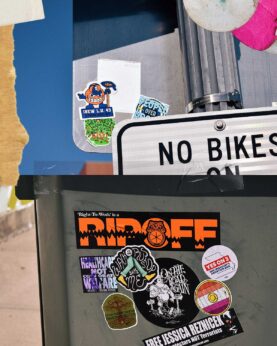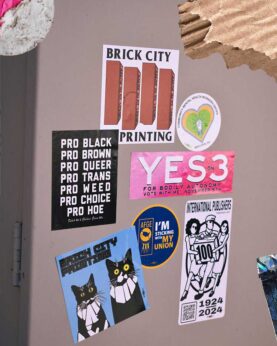
An earlier version of this article originally appeared in Sartorial, a student-run magazine for all things fashion, beauty, and culture published at the Missouri State University. Text by Bryesen Cooper. Photographs by Mikayla Buenta. The authors give special thanks to Nicholas James of Brick City Printing in St. Louis.
What do you think about stickers? If you walk through downtown Springfield, Chicago, New York City, Seattle, St. Louis, Rome, and Florence, you’ll notice that each city shares at least this one aspect: Their streetscapes are covered in stickers.
On every corner, lamppost, road sign, electrical equipment box, trashcan, or bench, you will see these objects covered with few to many stickers. Some showcase art while others highlight different groups, artists, and ideas—many of which may be unfamiliar.
Stickers have become a new medium for people to express their community, talents, and opinions. Just as graffiti rose to fame in inner cities, voicing the ideas and art of everyday working-class people, so did stickers. By easily ordering a sticker printer online or even buying custom stickers from a printing business, stickers are one of the most accessible means to effectively send a message to everyday people on the street, in the office, or driving on the road.

From major political organizations and big businesses to street artists and grassroots movements, everyone utilizes stickers to send a message. Talking to Nicholas James, artist and owner/worker of Brick City Printers, a unionized printing shop in St. Louis, we learn more about the importance of stickers and why their popularity is continually on the rise.
According to James, stickers help build legitimacy.
“Investing in something with an organization’s name on it makes the group feel more concrete,” he said.
Plus, when trying to disseminate a group’s messaging, stickers are an affordable alternative to flyers or t-shirts.
“Handbills are much more expensive than folks might think,” he said. “T-shirts are expensive and must be worn to be seen. Union-printed weatherproof stickers are around $80 for a hundred or so. Eight people can chip in $10 apiece easily.”
Talking to James, we also learned about different aspects of a well-made sticker.
“If they are (good) quality, they last for years and years,” he said. “The longer they last, the more they are seen. A high-tack weatherproof sticker takes serious effort, by either the weather or human hands, to be rendered unreadable.”
Stickers can easily be used to show opposition to forces seeking to split communities by simply sticking one over another.
“They can be used effectively to cover other stickers,” James said. “A hammer and sickle covers a swastika beautifully. It’s an excellent way to signal to other like-minded persons that there are comrades around. A 4-inch logo or org acronym can be legible from a car 30 to 40 feet away. It also signals to the opposition that their views are not welcome in the area. I see this play out in my own neighborhood park.”
There are also other qualities of stickers that outperform other forms of messaging on the street.

“Flyers need a roll of tape, or a bucket of wheat paste and a brush. Spray paint won’t fit in a pocket and rattles in a backpack. A back slit sticker (easy to peel) fits in most pockets and can be applied in literally five seconds. The benefit is the very low risk of being arrested or harassed by the police. Plus, stickers are not considered permanent by the legal system(s), despite the need for solvent and a razor blade to remove them.”
People use stickers to express their opinions on everyday issues, to show off their art, or to display their connection with their community. Many times, people resort to stickers because they feel their opinions have been ignored by the institutions of which our society is made up.
From “Free Palestine” to being against right-to-work laws, raising the minimum wage, and ending abortion bans, working-class people understand the connections of these issues being a fight against systemic oppression and exploitation.
In this, you’ll see rebellious acts of our communities voicing their support for these issues on your corners, lampposts, road signs, electrical equipment, trashcans, and benches, because this is where everyday people live, grow, and think about the environment around them.











